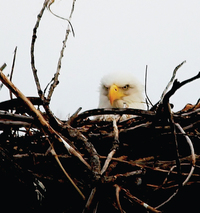I have been very fortunate through the years in my travels around our state, and states nearby, in seeking profound photography that would be moving to others. I do believe mostly in just being in the right place at the right time and many of my shots have just been by sheer luck. That is how I would describe most of my photography of Eagles. One of the most profound and majestic of animals in our area. Here is some well-known facts and history of the eagle, but also some interesting facts that you might not have heard about.
For centuries, people have seen eagles as a symbol of beauty, bravery, courage, honor, pride, determination, and grace. This bird is important and symbolic to humanity because of its characteristics. The Bald Eagle has been the national emblem of the United States since 1782 and a spiritual symbol for native people for far longer than that. These regal birds are not really bald, but their white-feathered heads gleam in contrast to their chocolate-brown body and wings. Look for them soaring in solitude, chasing other birds for their food, or gathering by the hundreds in winter. Once endangered by hunting and pesticides, Bald Eagles have flourished under
protection.
Bald Eagles rely heavily on fish and carrion where available. They readily adapt, however, to preying on waterfowl, other birds, rabbits, and other small mammals. They also occasionally kill adult deer, pronghorns, and calves. The average wingspan ranges from 6 to 7.5 feet. Eagles can achieve 30 mph using powerful wingbeats and even faster when diving after prey, Bald Eagles can dive at up to 100 mph; Golden Eagles at up to 150 mph. Bald Eagles and other cold weather birds have special circulation in their feet and legs that allow them to withstand very cold temperatures. Bird legs and feet also have little soft tissue, so they do not require as much warm blood flow. When they need a quick warm up, they can tuck one foot up against their body, underneath all those warm down feathers. An eagle has over 7,000 feathers. A Bald Eagle can carry about 1/3 its body weight. Eagles are powerful predators that can catch and kill prey many times their own size. However, they are unable to fly carrying more than just a few pounds. Whenever you hear a supposed eagle in a Hollywood movie or cartoon, it has been dubbed over by the screech of a red-tailed hawk. Eagle calls are quite soft and weak sounding and not considered cool enough for Hollywood. To impress each other, both males and females court each other by soaring to high altitudes, locking talons and tumble or cartwheel towards the earth! They do this to determine the “fitness” of their mate. Bald Eagles generally mate for life. Part of the courtship may include the dramatic talon clasping “cartwheel display” where two eagles grab each other’s talons high in the air and tumble through the air until breaking apart at the last moment. They look for nest sites in very tall trees, standing out above the surrounding forest, often near water. Both males and females help to build the nest, a giant mound of sticks lined with softer material. Nests may be reused and added to for several years, growing to 10 feet in diameter and weighing as much as
2,000 pounds! The number of eggs laid will depend upon species, but many eagles lay between one and three eggs; four egg clutches do occur, but they are rare. Bald Eagle parents take turns remaining with the young in the nest while the other brings prey home to feed the nestlings. Both male and female eagles will tear food into small pieces and feed it directly to the eagle chicks until they are old enough to begin pecking at food independently. The age of first flight is about 10 to 12 weeks. There are approximately 60 different species, with only 14 species found in North America. Eagles have amazing eyesight and can detect prey up to two miles away; sight is the strongest of all eagle senses. The eyes are large, and can take up almost 50% of the head, and can weigh the same amount as a human eye. Eagles can see five basic colors to our three and can detect UV light. The only time eagles are actively in the nest in when they are raising young. Eagles do not sleep in the nest; they perch on branches at night.
On average, male bald eagles weigh 25 percent less than females. Many eagles fly south for the winter and return north for the summer. But not all Bald Eagles migrate. Some of them, including individuals stick around all year. Whether or not a bird migrates depends on how old it is and how much food is available.
Winter is now upon us and if you have a love for this majestic bird as much as I do, get out and head towards the Missouri River for some eagle watching!





